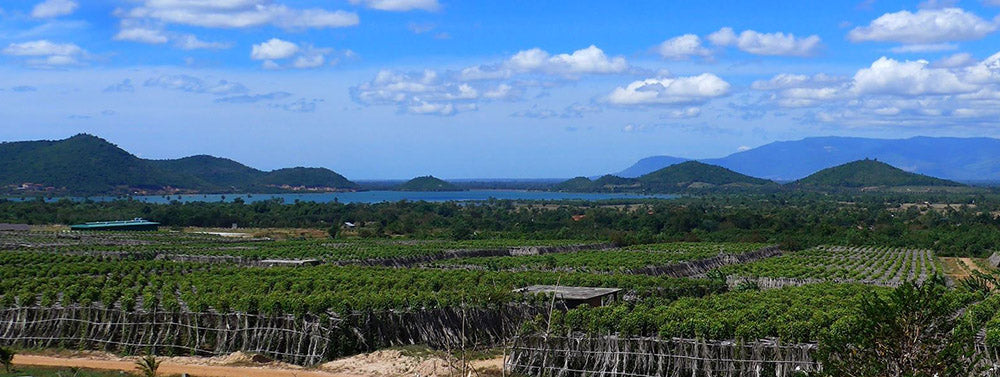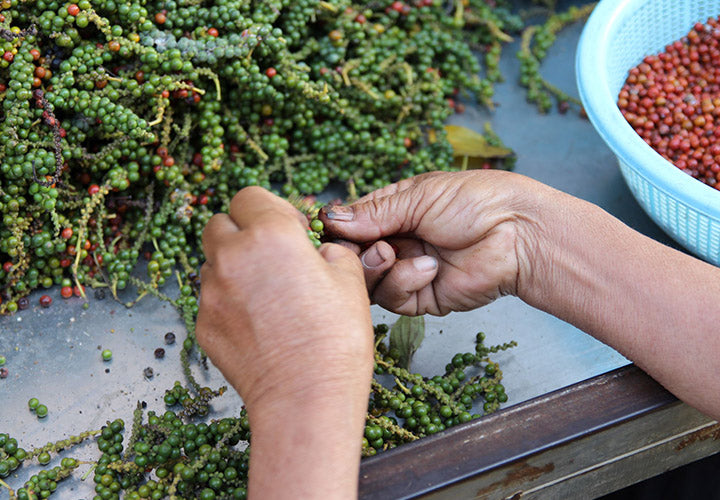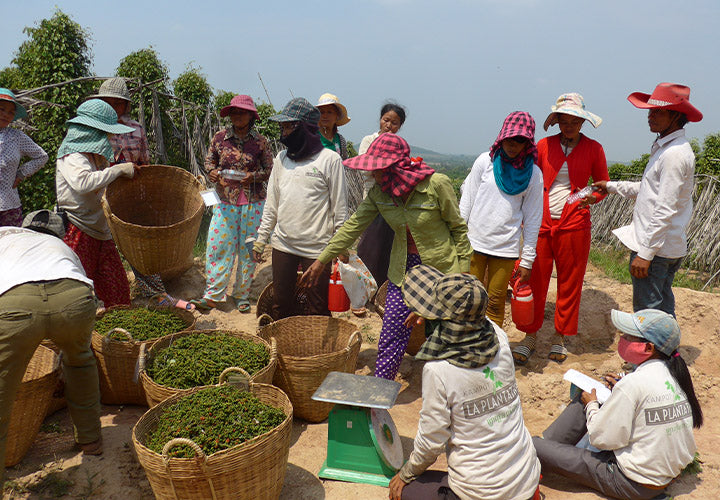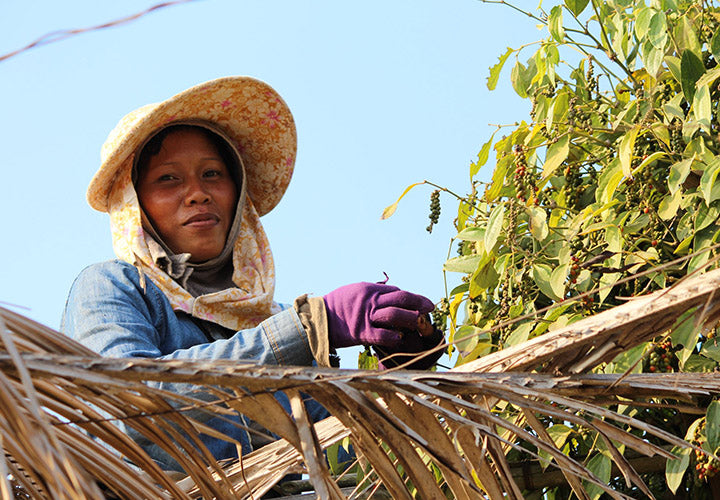12.08.2020
DEV: Spice Spotlight: Kampot Peppercorns

Any thoughtful cook can tell you the importance of grinding your own black pepper, but a serious gourmet will express profound enthusiasm for Kampot peppercorns. For centuries, this rare peppercorn cultivar has been favored by Cambodian cooks, French culinary elites, and spice aficionados from around the world.
A Brief History of Peppercorns in Cambodia
Black pepper (Piper nigrum) is native southern India and has been cultivated since 2,000 BC, but it is uncertain exactly when pepper cultivation began in Cambodia. One of the first writings about Cambodian pepper dates to the late 13th century when Chinese diplomat, Zhou Daguan, noted pepper being grown around the ancient city of Angkor.
Traders from Indonesia, Holland, and France have all played major parts in Cambodia's history with pepper. France’s Cambodian colonies and culinary authority popularized the Kampot pepper cultivar, especially in the early 20th century. If you dined at any respected Parisian restaurant during that period, your steak au poivre was seasoned exclusively with Kampot pepper.
Cambodian pepper production collapsed under the rule of the Khmer Rouge beginning in the 1970’s. Farmers were forced to produce food crops instead of peppercorns. It wasn’t until the early 2000’s that pepper farmers returned to their traditions and saved this pepper cultivar from disappearing entirely.
What Makes Kampot Pepper Special?
The southwestern province of Kampot lies at the foothills of the Dâmrei Mountains, where the warm, humid weather, elevation, and quartz-rich soil create goldilocks farming conditions. Peppercorn vines flourish in this environment, yielding a spice of superior flavor and aroma. Kampot peppercorns are considered the finest pepper in the world. They’re named after their region of production, just like Vidalia onions, Bourbon whiskey, and Roquefort cheese.
 Kampot pepper is the first Cambodian product to receive the French appellation d'origine contrôlée—a geographical indication that protects trade names for special food products, like Champagne. The European Union also granted Kampot pepper protected geographical indication status in 2016. This protection status ensures farmers are paid fairly for their pepper and that the quality is held to a high standard.
Kampot pepper is the first Cambodian product to receive the French appellation d'origine contrôlée—a geographical indication that protects trade names for special food products, like Champagne. The European Union also granted Kampot pepper protected geographical indication status in 2016. This protection status ensures farmers are paid fairly for their pepper and that the quality is held to a high standard.
Red Kampot peppercorns are particularly special. When the peppercorn clusters are ready for harvest, a few of the berries will turn blush red. When the pepper berry is at this stage, its fruity, sweet flavor is most present. These perfectly ripe, red berries are separated by hand before they are dried in the sun. This season we are carrying a special dark red variety, where only the choicest red berries are selected for this ultra-premium grade.
 When you open a bag of Kampot red peppercorns the aroma is distinctly peppery, but also sweet and fruity, like dried apricots. Twisting your pepper mill releases a strong pepper aroma that carries intoxicating hints of citrus peel, fresh berries, pine, and eucalyptus.
When you open a bag of Kampot red peppercorns the aroma is distinctly peppery, but also sweet and fruity, like dried apricots. Twisting your pepper mill releases a strong pepper aroma that carries intoxicating hints of citrus peel, fresh berries, pine, and eucalyptus.
Black Kampot peppercorns still embody these delicious flavors but are noticeably earthier and piney.
Cooking with Kampot Pepper
Like a fine finishing salt, Kampot black pepper makes a luxurious condiment at the dinner table. (Don’t forget to buy yourself a good pepper mill.) Since Kampot pepper is a rare ingredient, it is often reserved for recipes where its subtle qualities can stand out. Sauteed crab, steak au poivre, cacio e pepe, and Cambodian beef salad are excellent recipes to highlight this spice. This pepper is also delicious with sweet foods like freshly cut fruit, dark chocolate, or a scoop of vanilla ice cream.
Black pepper is a spice loved all over the world and pairs with nearly any other spice. For a more Cambodian flavor profile, try pairing it with spices like turmeric, ginger, star anise, cardamom, tamarind, and lemongrass.
Dipping sauces are popular in Cambodian cuisine. You can make your own with freshly cracked Kampot pepper, fish sauce, kaffir lime juice, and sliced scallions. This is an excellent condiment for any seafood, but especially grilled shrimp.
Kampot Pepper at The Spice House
We proudly source our Kampot peppercorns from La Plantation—a company making strides in socially and environmentally responsible spice production in Cambodia. Since 2013, La Plantation has fostered economic opportunities, cultural preservation, environmental sustainability, and access to education in rural Cambodia.
 Last year the company worked in collaboration with local farmers and members of the Kampot Pepper Promotion Association (KPPA) to launch a fair trade program for Kampot peppercorns. This fair trade program ensures that pepper is purchased directly from members of the KPPA at an equitable price. The program also guarantees close attention to food safety, quality control, and logistic efficiency that reduces the carbon footprint of each peppercorn.
Last year the company worked in collaboration with local farmers and members of the Kampot Pepper Promotion Association (KPPA) to launch a fair trade program for Kampot peppercorns. This fair trade program ensures that pepper is purchased directly from members of the KPPA at an equitable price. The program also guarantees close attention to food safety, quality control, and logistic efficiency that reduces the carbon footprint of each peppercorn.
 In collaboration with local farming traditions, La Plantation practices sustainable and certified organic farming. They employ 130 full-time employees, making them one of the largest employers in the region. In their commitment to social responsibility, the company also launched Les Écoles de La Plantation, a non-profit association that promotes early education in the rural province of Kampot.
In collaboration with local farming traditions, La Plantation practices sustainable and certified organic farming. They employ 130 full-time employees, making them one of the largest employers in the region. In their commitment to social responsibility, the company also launched Les Écoles de La Plantation, a non-profit association that promotes early education in the rural province of Kampot.
By purchasing these Kampot peppercorns, you are supporting positive change in rural Cambodian communities.
If you have a question about peppercorns or have a peppery recipe you would like to share, email us at spices@thespicehouse.com, or leave us a comment below!
Farm images courtesy of La Plantation.